Content
 The homeland of wild phlox is North America. There they inhabit meadows, river floodplains, forest clearings. The flower was brought to Europe by the famous plant hunter J. Tradescant at the beginning of the 18th century. Then active selection began, the result of which was varietal diversity. Phlox is grown in the open field. Almost all forms are unpretentious and require standard care. You can plant a plant with seeds, as well as any part of it.
The homeland of wild phlox is North America. There they inhabit meadows, river floodplains, forest clearings. The flower was brought to Europe by the famous plant hunter J. Tradescant at the beginning of the 18th century. Then active selection began, the result of which was varietal diversity. Phlox is grown in the open field. Almost all forms are unpretentious and require standard care. You can plant a plant with seeds, as well as any part of it.
Description of the varieties and varieties of phlox
The plant belongs to the cyanide family. The genus "phlox" itself has 85 species, which, in turn, are divided into groups:
- Shrub (low and high).
- Creeping.
- Loose sod.
The color of the petals, the shape of the leaves and inflorescences depend on the type and variety of the plant. We, most often, cultivate varieties from the transitional loose-leaf group of phloxes. These plants spread and branch, and their flowering stems rise 30–35 cm. The group includes the following species:
- stolon-bearing;
- Siberian;
- spread out;

Phlox bloom
- paniculate;
- rising;
- charming;
- smooth.
The spreading phlox includes 11 varieties and hybrids. The stems spreading along the ground easily take root, thus the plant spreads over large areas. The petals are wide, tapering towards the middle. The color is mostly blue. Flowers 2–5 cm in diameter are collected in bulky inflorescences. This species can grow in slightly shaded places on poor soils, it is resistant to cold weather, and winters well without shelter.
The most popular varieties of splayed phlox are:
- Chattahuchi, Digiro Ice, Blue Moon, Clouds of Perfume, Landen Grove, Blue Dreams (petals: lavender, blue);
- Fullers White, White Perfume, divaricata f. alba (snow-white petals);
- May Breeze, Home Fireers, Eco Tescas Purple (lilac and purple colors);

Montrose Tricolor variety
- Montrose Tricolor (considered one of the best varieties of the species, tricolor color on the leaves of the plant);
- Laphamia (variety with purple petals).
Flowering starts at the end of May and lasts about three weeks. Tall varieties bloom later, closer to autumn. Varieties and hybrid forms of splayed phlox are distinguished by a bright nectar aroma.
How to propagate and plant phlox
The phlox spreads out in a vegetative way. This is done by layering, basal and stem cuttings, a leaf with an axillary bud, or by dividing adult bushes.
June cuttings show the best survival rate. To do this, the stem is cut in such a way that 3-4 knots remain on each part. Leaves are pinched off from the bottom and placed at a slight angle in loose soil. The distance between the cuttings is 5 cm, in row spacings no more than 10 cm. Can be planted under a film cover. The next year, plants from the nursery are planted in open ground.
Phlox are grown without changing place for about 10 years. Old plants are rejuvenated by dividing the bush to produce several new plants. Do this before flowering or after, in cool, cool weather. The bush is dug out entirely, divided into parts, leaving at least three stems.
Advice. If, during reproduction by division, you have stems without roots, plant them - the shoots will easily take root in moist soil.
An interesting feature of phloxes is that they take root on shoots located near the ground. It is used for propagation by layering. The stems are artificially bent and fixed. Then, when the shoot is firmly established, the young plant is transferred to another place.

Phlox needs a sunny spot and nutritious soil
On a flower bed, phloxes are seated at a distance of at least 30 cm from each other. Lush bloom occurs only in well-lit areas with moderately moist nutrient soils. In full shading, the budding process may not occur.
Feeding phlox with fertilizers, seasonal care in the open field
Phlox are very responsive and grateful plants for good care. In the spring, as soon as the snow melts, two-year-old plantings and older bushes begin to feed. For 1 sq. m make:
- 30 g of ammonium nitrate;
- 30 g superphosphate;
- 45 g of wood ash.
The soil is carefully loosened no deeper than 5 cm, covering the fertilizers. The top layer is mulched with rotted manure.
Attention! Fertilizers are applied after precipitation or watering the beds.
For the entire season, phlox bushes need four liquid dressings. For plants of the first year, their number is reduced by up to three times, and watering rates are halved.
- The first feeding is done with a liquid, diluted mullein in a ratio of 1:15 or watered with ammonium nitrate (25 g per 10 l of water). Poultry droppings can also be diluted at a ratio of 1:25. The time of the event is early spring.
- In mid-June, watering is carried out with the same composition, adding potassium salt (10 g per 10 l) and ash (25-30 g per 10 l).
- In early July, superphosphate (10 g) is added to a liquid organic solution.
- At the end of July, a liquid solution of min. fertilizers:

Feed the phlox several times per season
- superphosphate 15 g;
- ammonium nitrate 10 g;
- 30 g of ash (can be replaced with 10 g of potassium salt).
At the final stage of flowering, phosphorus and potassium are added (in order for the plants to accumulate enough substances for wintering).
Beds with phlox are watered abundantly on hot days, weeded and loosened, mulched. Well-groomed beds with mulch retain moisture longer, and this planting also overwinters more easily. If the winter is not very snowy, then dry foliage and branches are thrown over the area with phlox. It is undesirable to trample or compact the snow, as the ice crust will destroy the plants.
Diseases and pests of phlox, we combine a flower with other plants
Phloxes are completely non-capricious and easy to care for, but they also need to be treated from pests. In wet, damp weather, white bloom is often found on the leaves - this is a sign of powdery mildew. The disease begins from inconspicuous points, developing into large spots that resemble burns. As a preventive measure, preparations containing copper are introduced, the soil is mulched with ash, and complex mines are introduced. additives. Maintain the cleanliness of the site, getting rid of dry plant residues in time.
If the infection has already occurred, then spray with "Fundazol". There are also folk remedies:
- sour whey or kefir;
- strained infusion of cow dung diluted with water 1:10;
- infusion of wood ash and soap (for 1 liter of boiling water 125 g of ash + 5 g of household soap).
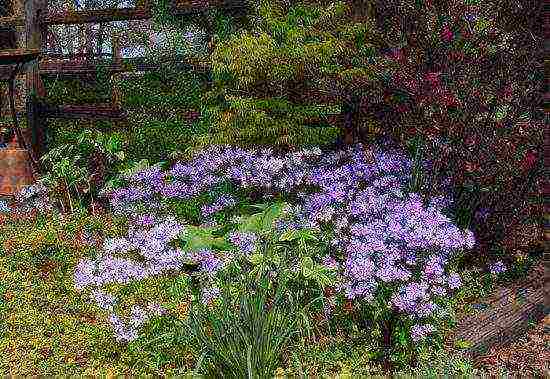
Phlox in landscape design
Phlox infected with insects are best removed along with the root and burned. Plants are affected by nematodes, thrips. The site is not recommended to be used for several years for new plantings of phlox.
In decorative plantings, you can combine any varieties and types of phlox with other crops. Phloxes are planted in a solid carpet or in separate groups. For flower arrangements, varieties with a harmonious color combination are chosen. Kohler smoothly goes from light to more saturated.
Planting species of different flowering times, phytodesigners achieve a continuous riot of colors. For example, compositions from spring aquilegia, summer delphinium and autumn phlox are good. Low-growing varieties of phlox are placed in flower beds in front of lilies, peonies, asters. High late varieties, planted next to flowering shrubs. Phloxes will take over flowering in late summer.
Today, undeservedly forgotten phlox are experiencing a revival. This is manifested not only in the high interest of gardeners, but also among breeders.New hybrids and varieties of this bright plant have been bred, which can be seen in the photo from catalogs.
Spreading phlox: video
 Nice and unpretentious flowers
Nice and unpretentious flowers
Have you already thought about what to plant in your garden in the new season? We recommend that you decorate the landscape with phlox. Say, they say, well, they were surprised, they grow in everyone's dacha. But flowers can be of different types and varieties. Our topic today is planting a splay phlox and caring for it. These flowers are different from those to which everyone is accustomed, they are great for decorating rock gardens, borders, rockeries. We advise you to read the article further.
Description of the species  The inflorescence looks like stars
The inflorescence looks like stars
Spreading phlox is a species that has its own varieties, each with its own characteristics, unique data. Now summer residents are increasingly looking for some kind of exclusive plants so that the landscape looks like pictures from different magazines. In addition, in our time, it has become possible to buy seeds and seedlings even in the most remote corners of the country, thanks to online stores. But nevertheless, the flowers that are familiar and traditional for our sites still remain relevant. The same phloxes are very unpretentious, do not require special care and complex agricultural technology, while in return they give their beauty and wonderful aroma.
The peculiarity of splayed phlox is that the plants are undersized - the maximum bushes can reach 40 cm, more often 25-30 cm. Such diminutiveness makes it possible for widespread use in landscape design. After all, ordinary phloxes are tall, they cannot decorate an alpine slide, a garden of stones, a garden pond. These flowers are more suitable for decorating along fences. Low-growing phloxes can grow along paths, be planted in flowerpots on the veranda, and create a living flowering carpet.
On a note! Phlox was first described by Karl Linay in the 18th century, but flowers were known thousands of years before. Wild varieties can be found in different parts of the world.
Photos of splayed phlox show us that their colors are mainly lavender, blue, not so often you can find pink, white or purple shades. The inflorescences themselves also differ from the traditional look - they have wide edges, there are usually five petals, the shape tapers towards the middle. Flowers in diameter - 2-3 cm, begin to delight from the second decade of May to August, there is a small fluff on the leaves. Spreading phlox thinning a pleasant and delicate aroma.
 Heavenly shade
Heavenly shade
Do you know what else is unique about splayed phlox? To pollinate these flowers, and they need pollination, only certain types of bees and insects are needed. They must have a long proboscis, while other insects do not get nectar due to the special shape of the flowers. The spread-out look is perennial flowers, in general, all types of phlox grow in flower beds for more than one year, except for "Drummond".
Now it is difficult to say exactly where this species came from. If we talk about wild ancestors, then they can be most found in North America. There they prefer to grow in meadows, where it is moderately humid and warm. Now there are more than fifty varieties of spread-out phlox, some of which we will describe to you a little later. It is these flowers that most summer residents prefer, you can also decorate your garden with them.
Well, let us tell you about planting and caring for a splayed phlox, and then we will introduce you to good varieties.
How to create a flowering carpet or phlox farming technique
Place for flowers
Plants such as phlox are quite unpretentious. They can be planted and barely tended, and you will still see flowering. But summer residents who take care of their garden dwellers know that when you pay more attention to flowers, trees or vegetables, then always the return is not long in coming. So it is with splayed phlox. If you want to see such abundant flowering as in the photo, continue it for 1-2 decades, then consider what we will write next.
 Phlox field
Phlox field
So, it is generally accepted that phlox grow both in the shade and in the sun.But this is not entirely true, in the first case, the bushes stretch out strongly and give meager flowering, in the second they burn, become loose, the flowers dry. Yes, phlox are light-loving flowers, but it is better to plant them in partial shade or in places where the sun is hidden at noon. Then your bushes will be completely covered with inflorescences, they will be bright, without dry edges.
Also, you can not plant splayed phloxes where large trees grow, flowers with powerful roots. In the battle for light and nutrients in the soil, the first will lose. It is better not to plant plants where there is a lot of weed, especially if you can not weed it very often. The reason is as follows:
- a large number of weeds is an accumulation of pathogenic flora, and phloxes cannot be called absolutely resistant to diseases;
- the herb has long, branchy roots, while the flowers are weak and shallow. The former will interfere and take away all the nutrients;
- when the weed grows through the phlox, then when pulling it out there is a risk of pulling out the flowers. The bushes, of course, will not die, but the decorative effect will be spoiled.
Soil for flowers
Widespread phloxes are undemanding to the ground, but again, fertile land prolongs flowering. Therefore, it is better to plant on a fertilized site and apply 3-4 feedings for the entire growing season. This makes it possible to extend flowering for a decade. But what phloxes are very capricious about is stagnant soil. The roots are sensitive to water, its accumulation during the thaw period, there should be no floods on the site.
Saplings
 It's easy to buy seedlings
It's easy to buy seedlings
Most often, splayed phloxes are bought on the market or taken from someone on the site. Flowers reproduce very easily by dividing the root and cuttings, so it is better not to plant them with seeds, but ask your neighbor in the country. Seedlings take root very quickly, even cuttings that are left without roots during digging are placed in the ground immediately, and they take root. Summer residents who grow wide-spread phlox always have their remnants, because the flowers are pruned, they are limited in growth in the flower bed.
On a note! Phloxes can grow in one place for more than ten years without losing their decorative effect with minimal annual maintenance.
Planting in a flower bed and care
 Flowers are very fond of sunlight diffused light.
Flowers are very fond of sunlight diffused light.
You have saplings of phlox spread out, the place has been chosen. Now you need to remove all the weeds, we can advise you to shed the grass with the Roundup preparation 2-3 weeks before the planned planting. It acts through the leaves on the whole weed, it dies. Before planting for 3-4 days, the site is disinfected with boiling water with manganese - the pathogenic flora and the remaining roots die. Now the soil is dug up and small depressions are made under the creeping roots of the splayed phlox. A 1-2 cm layer of perlite or crushed stone is laid on the bottom for drainage. From above it is covered with humus mixed with a glass of wood ash by a third.
Seedlings are placed in the holes and filled up, the earth is tamped around the roots. Planting is watered abundantly. For the first two weeks, phloxes will take root and they do not need anything but water. After 14 days, you can apply a fertilizer with a high nitrogen content to build up greenery. To do this, dilute 25 grams of chicken manure in a bucket of water and spill the flower bed under the root in the evening. In the morning, after each moistening, you need to loosen the soil, but be careful with superficial roots. It is better to remove weeds as they appear, so that the roots do not have time to grow very much.
Two weeks after the first feeding, you can add a second one based on potassium and phosphorus. Potassium salt and superphosphate are suitable. After flowering, only phosphorus fertilization is applied. You can use a mixture of potassium salt and fluoride for splay phlox. During the season, several foliar feeding is carried out on the basis of infusions on weeds, dry bread. For the prevention of diseases, a weak solution of manganese is periodically used.
For information! Foliar subcortex is spraying.It helps to assimilate substances through the leaves, it is carried out only in dry and cool weather, not in fog.
After the flowers have faded, gradually reduce watering to 1-2 times every 14 days. Experienced gardeners recommend pruning phlox, and we agree with them. So, next year, the bushes will have a more decorative look, dry parts will not spoil the aesthetics, and pruning will rejuvenate the plants. Therefore, in the fall, you need to feed it with any preparation where there is no nitrogen, so that phloxes do not start growing again, cut off the aerial part, leaving 10 cm from the ground. From above, it is better to close the planting with mulch, since in our time, winters can be completely snowless, the bushes risk freezing out.
Reproduction of splayed phlox 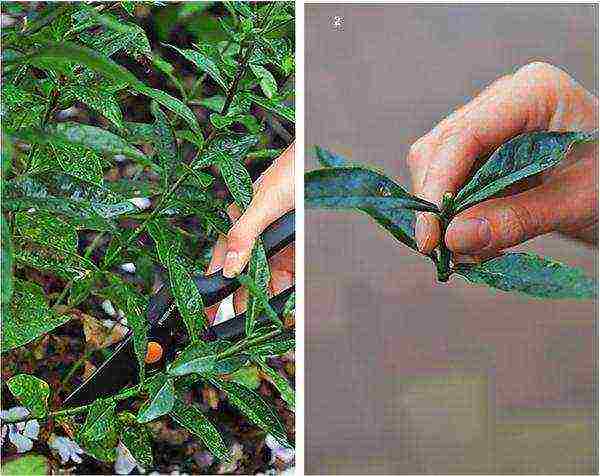 Flowers can be propagated in many different ways.
Flowers can be propagated in many different ways.
Of course, speaking about planting and care, you need to tell you about how to increase the area of flowers in the garden. This is done, as we have already said, it is very simple - by dividing the root or by cuttings.
- In the first case, in early spring or autumn, the bushes are dug up, the root system and the aboveground part are divided into components. After that, all the seedlings are planted in a nutritious soil.
- In the second case, the shoots are cut into pieces of 8-10 cm, put them in "Kornevin" dissolved in water and wait for the appearance of roots. You can simply plant the cuttings at an angle in the sand. Soon they will give roots and can be transplanted to a permanent place.
Diseases and pests  Spider mite
Spider mite
Wide-spread phloxes do not especially suffer from parasites and ailments. The latter more often arise from improper care and the presence of weeds. As a rule, flowers are sick with powdery mildew, phomosis, septoria. In the fight, you need to use drugs - fungicides, copper sulfate, Bordeaux mixture, according to the instructions. You need to act as soon as you notice signs of defeat.
Advice! To protect the flower garden from diseases, spray it with "Fundazol" 1-2 times a month - an excellent prevention of adult plants and seedlings.
There are a lot of insects that can, though infrequently, but still bother phloxes - caterpillars, slugs, aphids, ticks, leaf rollers. They need to be dealt with drastically. You can choose insecticides - "Fury", "Aktaru", "Bi-58 New", "Karate", "Kinmiks", "Sumi-Alpha" or folk methods. It can be an infusion of tansy, ash, tobacco dust, onion husks, spices. Well, as we promised, it's time to introduce you to the best varieties.
How to choose splayed phloxes for the beauty of your garden?
We advise you to take a closer look at the following varieties of splayed phlox:
- BlueDreams. The flowers look like lilac stars with a dark center.
 Nice shade to decorate the garden
Nice shade to decorate the garden - "Clouds of Perfume". This variety smells like lavender, and the petals are lilac.
- "Variegata". The leaves delight with their variegated color.
 A rare shade of pink for the look
A rare shade of pink for the look - May Breeze. The variety surprises with its large flowers. Their color is lilac-white, the middle stands out.
- Montrose Tricolor. The name is given for the special shade of the petals - with a border, the inflorescences themselves are blue.
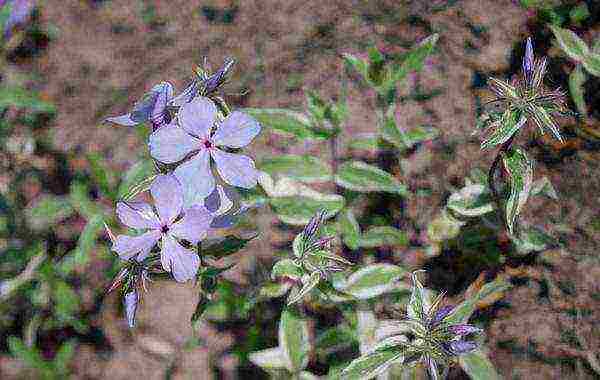 Unusual leaves among phlox
Unusual leaves among phlox - Fullers White. A beautiful and delicate variety of white color.
Agree that splayed phloxes look very aesthetically pleasing in a flower bed, add decorativeness to stones and paths. With such a light agricultural technique, you just need to plant these beautiful flowers at your place.
Folk legends and signs  Our ancestors appreciated phlox hundreds of years ago
Our ancestors appreciated phlox hundreds of years ago
You know that there are many myths associated with many plants and trees. Phlox, we have already noted, have been growing on our planet for more than one hundred and thousand years, there are even legends that were folded by the ancient Greeks. But today we will not tell about them, but about our ancestors. There was such a story in Russia.
A beautiful girl lived in one village, she knew how to sew beautifully. Of course, she had a beloved fiancé, yes, fate decreed that her beloved was taken to the war. There was no limit to the sadness and anguish of the beautiful dressmaker, but she did not leave her life's work.From morning till night she sat by the window sewing clothes for people, waiting for her betrothed. Tears flowed from her eyes, and the needle once pricked her finger. The blood flowed to the floor, later turning into beautiful flowers - phlox.
On a note! Folk healers believe that if you make an infusion on phlox inflorescences, and then wash your face, then skin ailments and all sorrows disappear.
Whether with this legend or not, it is difficult to say that in Russia flowers have become a symbol of endless, devoted love. It is believed that phlox can awaken the feelings of even the most soulless person. Folk traditions have many tips on how to use flowers for love and more. For example, if feelings in the family began to grow cold, then red or burgundy phlox should be placed next to the bed or sleeping spouse.
Moreover, it was believed that if a person has an enemy, then so that he could not do evil, you can bury a dried phlox near his house. Of course, for some, this is all fiction, but bouquets of phlox at home can really not only decorate the decor, but also fill it with positive energy, a subtle aroma. It is believed that flowers should always stand next to the entrance, and not only phloxes, so negative energy will not get into the house.
Moscow, Russia, on the site since 11.01.2017

Split phlox (Phlox divaricata) is one of the most popular types of garden phlox. In the wild, it lives in the eastern United States and Canada. It is found in mountainous regions and in humid forests, where it forms blue carpets on gentle slopes.
Perennial plant, forms small loose bushes 25-30cm tall. Leaves are oblong or lanceolate, up to 5 cm long. Branching stems, lying at the base.
In phlox spread out, flowers with a diameter of about 2 cm are collected in corymbose inflorescences. The number of flowers in one inflorescence is less than that of paniculata phlox, only about 10 pcs. But the flowering is plentiful, the bushes are covered with many flowers. They are bluish lilac, pale lavender or lilac. Some garden varieties have a purple eye in the center. Flowering begins in May and lasts approximately 30 days. In cool weather and in shade, phlox blooms longer than in the sun in hot weather.
In the nodes of the shoots, as in the styloid phlox, adventitious roots are often formed if the soil is sufficiently moist. The plant is propagated without much difficulty by dividing the bush or cuttings are rooted. Even a novice gardener can easily grow such phlox.
The splay phlox adapts very well to almost any conditions. In nature, it can be found in the shade of forests, among grass and shrubs, on rocky mountain slopes. This species of the vast genus Phlox grows both on poor sandy soils and on a thick litter of deciduous humus in forests.
The use of phlox spread out in garden design
Spring-flowering low phloxes are used in landscape flower beds, they go well with tulips, yellow daisies. But best of all they look like large curtains or carpets among the greenery.
Phlox is a splayed shade-tolerant plant, therefore it is used in penumbra compositions in the garden or near a pond. It can also be used as a ground cover plant under thin crowns of trees or shrubs.
In rocky gardens, low phloxes are also often used, especially on shady slopes. The north side of the alpine slide is good for a splayed phlox.
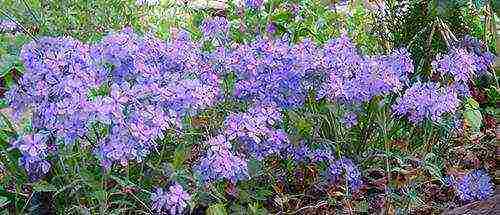
Tips for growing splay phlox
Lighting and landing... Grows well both in the sun and in the shade. For splayed phlox, an almost ideal place would be a shaded garden spot at noon with several hours of sun in the morning or in the spring.
Bushes are planted at a distance of about 30 cm. Gradually expanding, the curtains can merge into a solid carpet.
Watering... The plant is not demanding in watering, it is not watered in the shade, in the sun in drought it is sometimes watered for the growth of green mass before flowering.
The soil... Split phlox is not a soil-demanding plant, but grows best on loose, free-flowing soils.
Reproduction... Phloxes of spring flowering practically do not give seeds, therefore they are propagated vegetatively by dividing old bushes or by rooting cuttings. The ability of the stalks of splayed phlox to form roots at the nodes of the shoots, where they come into contact with the soil, makes the task of reproduction quite simple.
Reproduction by layering. The simplicity of this method is obvious: at the beginning of summer, the stems are laid out on pre-loosened and moistened soil and pressed with pebbles or pressed with slingshots from the branches until the time when roots and new shoots appear. The mail is moistened periodically. In the spring, young bushes are transplanted.
Propagation by cuttings. To quickly obtain a large amount of planting material, long stems are cut into pieces with 3 to 4 internodes. Leaves and side branches are removed from the lower two internodes. You can also use the tops of the stem. The soil should be loose and light. Cuttings are planted obliquely in a greenhouse or on a special shaded bed at a distance of 5 to 10 cm from each other. Plantings can be covered with plastic wrap to retain moisture in hot, dry weather. Young plants are planted in a permanent place next spring.
Reproduction by dividing the bush. In early spring, they dig out a bush, divide it into parts with roots and plant it. It is best to do this on a cool, cloudy day. If some shoots have fallen off without roots, it does not matter, they can be planted in the ground in a shaded place with moist soil and cuttings root. You can divide the plants after flowering.
Spreading phlox (Phlox divaricata) or as it is also called "Canadian" is originally from North America and Canada, where it grows in forests, along streams and on gentle mountain slopes, which are covered in spring with magnificent flowering carpets of all shades of blue, white or lilac.
Due to its unpretentiousness and spectacular abundant flowering, this type of culture can be found in almost any garden. Flowering occurs in mid-late May and lasts almost a month.
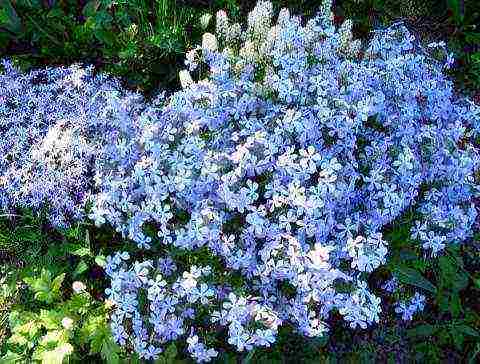
Reproduction and care
Spreading phlox is a perennial low plant with branching stems that lie at the base of bushes, the height of which is 20-30 cm. The formation of adventitious roots in the nodes of leaf stems contributes to their rooting, especially when maintaining soil moisture.
Because of this feature, phlox grows quickly and is easily propagated by cuttings of shoots - just cut off a young shoot and place it in a moist substrate. Another breeding method is to divide overgrown bushes in early spring or autumn. Delenki are planted at a distance of 25-30 cm and after a while they form beautiful clumps.

The plant prefers a soil rich in humus or leafy humus, loose and permeable to moderate moisture. It grows well both in the sun and in partial shade under the crowns of trees and bushes. A layer of mulch around the bushes during the summer helps to retain moisture and prevents the roots from overheating. In a dry period, due to a lack of moisture, the plant can go into "hibernation", but next spring it will start growing again.
Powdery mildew can be a serious problem, and to reduce the risk of fungal diseases around the plantation, good air circulation, water stagnation and stem pruning should be done. This procedure also promotes re-flowering.

Popular in garden design include Blue Moon with blue-blue flowers, White Perfume and Chattahoochee with a pink spot in the center of the flower. The plant is used as a ground cover for decorating rockeries and alpine hills.In the sun, his companions are tulips, muscari, peonies. Plantings look spectacular in shady areas of the garden with ferns, lilies of the valley, dicentra, hosts, trillium, creating a real forest landscape.
Did you like the article? Vote!
1 1 1 1 1 Rating 5.00


